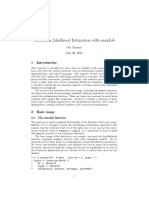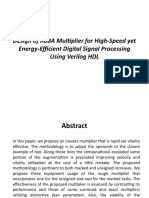Robust Controller Design Using Multi-Objective Optimization Power Management DesignLine
Uploaded by
Ivana PrezimeRobust Controller Design Using Multi-Objective Optimization Power Management DesignLine
Uploaded by
Ivana PrezimeRobust controller design using multi-objective optimization| Power Management DesignLine Page 1
All Articles Products Courses Papers News
Webinars Web
Site Search:
Welcome, Design Learning Product Site
Home RSS News Blogs Forums Careers
Guest Center Center Center Features
March 10, 2008
Robust controller design using multi-objective optimization
By Joel Steenis, National
Semiconductor
Power supply designers are well aware of the tradeoffs encountered in the design process, and the
accompanying challenges. One of the toughest tasks in designing a controller is to meet stringent
requirements for transient response while maintaining a robust system. But the typical designer may not be too
familiar with the subject of control systems and optimization techniques as they apply to the DC/DC design,
nor the software tools best for the job. Here's what you need to know.
The theory
Many computational software tools available contain optimization functions. The algorithm may be thought of
intuitively as minimizing the difference between the solution of the function that describes the system, and the
desired outcome. The problem may be represented mathematically as:
Minimize χ,ξ,
ξ such that:
f(x) – weight • ξ ≤ goal
Subject to the constraints:
c(x) ≤ 0
c eq(x) = 0
Ax ≤ b
Aeqx = beq
lb ≤ x ≤ up
The problem formulation above may be thought of intuitively as a minimization problem that has some degree
of slackness given by the term weight • ξ. Slackness may be thought of as the degree of over or
underachievement of the goal. The amount of slackness depends on entries in the "weight" vector. If a goal
must be achieved exactly, one may set the weight for that objective function equal to zero. The constraints
may be thought of as the feasible region for solutions to the problem. For example, resistors and capacitors
cannot have negative values. Therefore, if x is a vector that represents resistors and capacitors in a circuit,
one may set the lower bound (lb) constraint equal to zero.
One popular algorithm that is used to solve constrained multi-objective optimization problems is sequential
quadratic programming (SQP)[1]. The SQP algorithm may be thought of as a modified form of Newton's
method and converges in relatively few iterations. This algorithm is implemented in MATLAB's fgoalattain
function and simplifies the development of an optimization routine.
http://www.powermanagementdesignline.com/206902612;jsessionid=3XF4FKUQEETB... 03/14/2008 09:44:30 AM
Robust controller design using multi-objective optimization| Power Management DesignLine Page 2
Software implementation
The SQP algorithm implemented in MATLAB's fgoalattain function has input arguments that include the
function to be optimized, initial values, goals, goal weights, constraints, and a variety of options to display the
goal attainment progress or exit condition. To implement the function "fgoalattain" in MATLAB, the following
form may be used:
[x, fval, attainfactor] = fgoalattain(fun, x0, goal, weight, A, b, Aeq, beq, lb, ub, nonlcon, options)
Using a controller design example, the input argument fun is a MATLAB function that may return parameters
such as overshoot, rise time, and some measure of robustness of a closed loop switchmode power supply.
The input argument x0 are the initial controller values and may be calculated using standard rules of thumb [2]
. The weights may be chosen according to the relative importance of the design goals. For equal weighting of
the design goals, set the variable weight equal to absolute value of the goal vector. If a weight is set equal to
zero it will be treated as a hard constraint and the solver will prioritize that goal.
The input arguments A, b, Aeq, beq, lb, up, and nonlcon are constraints as described in the previous section.
The values for the constraints depend on the design space the designer is able to work within. If a constraint is
to be ignored, a set of braces "[]" may be entered in its place. The input argument options allows several
internal parameters of the solver to be printed to the command window. Using this feature can be useful to
check the progress of a particular computation.
For illustrative purposes, consider the following simple example, where the goals are pole locations. Let a
system be described by the transfer function:
where a is some design parameter.
Let the design goal be to have the system poles at s = –1 rps, –10 rps, and –100 rps. This may be done using
the following code:
function a = root_loc
a0 = 1; % Initial guess for a
goal = [-100 -10 -1]; % Pole placement goal
weight = abs(goal); % Equal weighting of goals
options = optimset('LargeScale', 'off', 'Display', 'iter', 'GoalsExactAchieve', 3); [a,fval,attainfactor] = fgoalattain
(@sysfun,...
a0,goal,weight,[],[],[],[],[],[],[],[]) % Optimization function
function r = sysfun(a) % System function
sys_den = [1 111 1110 a]; % Denominator of system transfer function
r = roots(sys_den); % Calculate the poles of the system
end
end
After the program executes the code above, the following appears in the MATLAB command window:
Optimization terminated: magnitude of directional derivative in search
direction less than 2*options.TolFun and maximum constraint violation
is less than options.TolCon.
Active inequalities (to within options.TolCon = 1e-006):
lower upper ineqlin ineqnonlin
1
2
3
http://www.powermanagementdesignline.com/206902612;jsessionid=3XF4FKUQEETB... 03/14/2008 09:44:30 AM
Robust controller design using multi-objective optimization| Power Management DesignLine Page 3
a = 1000.00000002537
fval = -100.000000000003
-9.99999999996868
-1.00000000002847
attainfactor = 3.77294549557555e-013
Here we see that the program terminated because it could not make significant headway in performing
additional iterations. Note that very small attainment factors indicate that the goals are almost exactly met.
Beyond that consideration, positive values indicate underachievement; and negative values indicate
overachievement. In this case, the design objectives were met for all practical purposes.
For more information on the function fgoalattain, refer to The Mathworks website (www.mathworks.com). To
see the MATLAB code that implements the fgoalattain algorithm, simply type "type fgoalattain" at the MATLAB
command line prompt.
Design example
As an example of how powerful this approach can be, assume a buck regulator with type 2 controller is to be
designed with the following specifications:
Maximum overshoot ≤5 percent
Rise time ≤100 microseconds
The controller must also be robust, having gain and phase margins on the order of 10 dB, and 53 degrees,
respectively.
Let's use the National Semiconductor LM2657, an adjustable 200-to-500 kHz sychronous buck regulator. It's a
dual-channel voltage-mode controlled type for high-current applications. The LM2657 requires only n-channel
FETs for both the upper and lower positions of each stage. It has the following parameters and operating
conditions:
V OUT = 2.5 volts
I = 4 amps
OUT
L = 10 microhenries
C = 100 microfarads
RESR = 90 milliohms
Modulator Gain, A = 10 V/V
Switching freq = 300 kHz
(Click on Image to Enlarge)
Figure 1: Buck regulator with type 2 compensation
Assume that the transient performance is of greater importance than robustness and is weighted
appropriately. A multi-objective optimization routine that incorporates the disc margin measure of gain and
http://www.powermanagementdesignline.com/206902612;jsessionid=3XF4FKUQEETB... 03/14/2008 09:44:30 AM
Robust controller design using multi-objective optimization| Power Management DesignLine Page 4
phase margin (i.e., disk margin is a measure of robustness based on the Nyquist plot and a disc centered at
the point –1, 0) is then executed. The routine generates the following numbers:
Overshoot = 6.6 percent
80 percent rise time = 103 microseconds
Gain Margin = 7.23 dB
Phase Margin = 72.8 degrees
It then calculates the component values: R2 = 42.3 kilohms, R3 = 7.52 kilohms, C2 = 2.36 pF, C3 = 1.99 nF
The loop gain, and system transient response are shown in figures 2 and 3, respectively.
(Click on Image to Enlarge)
Figure 2: Loop gain, buck regulator
(Click on Image to Enlarge)
Figure 3: Transient response, buck regulator
Note that the design goals have been underachieved. At this point the designer may choose to either try
meeting the goals using type 3 compensation, reconsider the importance and therefore the weights of the
given specifications, or simply accept the given design. Typically, the designer will accept the results of an
initial paper design since the measured results invariably deviate from those calculated.
http://www.powermanagementdesignline.com/206902612;jsessionid=3XF4FKUQEETB... 03/14/2008 09:44:30 AM
Robust controller design using multi-objective optimization| Power Management DesignLine Page 5
Summary
Given a set of requirements, the variables in a system model may be adjusted to meet those requirements
using multi-objective optimization. The MATLAB function fgoalattain faciliates this optimization. Applications of
such routines are far reaching and may be extended to any area of power electronics.
About the author
Joel Steenis, a circuit design engineer for National Semiconductor, has degrees in electrical engineering and
mathematics from the University of Arizona in Tucson. He is currently pursuing a masters degree in electrical
engineering at the University of Southern California.
References
[1] Gembicki, F.W., "Vector Optimization for Control with Performance and Parameter Sensitivity Indices,"
Ph.D. Dissertation, Case Western Reserve Univ., Cleveland, OH 1974
[2] Steenis, Joel, "Compensating Voltage Mode Buck Regulators," Power Management Designline 2006
TechOnline Communities
TechOnline | Audio DesignLine | Automotive DesignLine | CommsDesign | Digital TV DesignLine | DSP DesignLine | EDA DesignLine |
eeProductCenter
Industrial Control DesignLine | Mobile Handset DesignLine | Planet Analog | Power Management DesignLine
Programmable Logic DesignLine | RF DesignLine | Video/Imaging DesignLine | Wireless Net DesignLine
EE Times
United States | Asia | China | Europe | France | Germany | India | Japan | Korea | Taiwan | United Kingdom
Additional Network Sites
Industrial Control Europe | RFID World | DeepChip | Embedded.com | Design & Reuse | Electronic Supply and Manufacturing |
Electronik iNorden | Microwave Engineering Europe
All materials on this site Copyright © 2008 TechInsights, a Division of United Business Media LLC. All rights reserved.
Privacy Statement | Your California Privacy Rights | Terms of Service
http://www.powermanagementdesignline.com/206902612;jsessionid=3XF4FKUQEETB... 03/14/2008 09:44:30 AM
You might also like
- Experiment 10 - Root Locus Design Method For DC Motor Speed ControlNo ratings yetExperiment 10 - Root Locus Design Method For DC Motor Speed Control4 pages
- Using Synthesis Techniques for Power ReductionNo ratings yetUsing Synthesis Techniques for Power Reduction9 pages
- Overcoming Power Compiler limitations to optimize clock gating PDFNo ratings yetOvercoming Power Compiler limitations to optimize clock gating PDF19 pages
- WSB004 Coursework 2 Info Sheet - Motor Position Control V1.1No ratings yetWSB004 Coursework 2 Info Sheet - Motor Position Control V1.111 pages
- Design of Roba Multiplier For High-Speed Yet Energy-Efficient Digital Signal Processing Using Verilog HDLNo ratings yetDesign of Roba Multiplier For High-Speed Yet Energy-Efficient Digital Signal Processing Using Verilog HDL16 pages
- Resonant LLC Converter For 3.3 KW On Board EV ChargerNo ratings yetResonant LLC Converter For 3.3 KW On Board EV Charger11 pages
- Control System Lab EEE 5th Sem 14092023No ratings yetControl System Lab EEE 5th Sem 1409202348 pages
- ML0101EN Reg Mulitple Linear Regression Co2 Py v1No ratings yetML0101EN Reg Mulitple Linear Regression Co2 Py v15 pages
- CS211 Test Two 20072022 - Solution - MarkedNo ratings yetCS211 Test Two 20072022 - Solution - Marked12 pages
- Lab 2: Modifying Legup To Limit The Number of Hardware Functional UnitsNo ratings yetLab 2: Modifying Legup To Limit The Number of Hardware Functional Units8 pages
- Algoritham and Architectural Level MethodologiesNo ratings yetAlgoritham and Architectural Level Methodologies44 pages
- High-Speed and Low-Power Multipliers Using The Baugh-Wooley Algorithm and HPM Reduction TreeNo ratings yetHigh-Speed and Low-Power Multipliers Using The Baugh-Wooley Algorithm and HPM Reduction Tree4 pages
- Fundamentals of Machine Learning Support Vector Machines, Practical SessionNo ratings yetFundamentals of Machine Learning Support Vector Machines, Practical Session4 pages
- konigstein2_v-8_ScrambledContent_chapter-9No ratings yetkonigstein2_v-8_ScrambledContent_chapter-910 pages
- Department of Electrical and Electronics Engineering Matlab Theory and Practice (ELEC 403) Module V, Assignment 5No ratings yetDepartment of Electrical and Electronics Engineering Matlab Theory and Practice (ELEC 403) Module V, Assignment 56 pages
- UNIT-1_MATLAB PROGRAMMING_QUESTION BANK_SOLUTIONNo ratings yetUNIT-1_MATLAB PROGRAMMING_QUESTION BANK_SOLUTION25 pages
- Process Capability Evaluation - Looking Beyond The ObviousNo ratings yetProcess Capability Evaluation - Looking Beyond The Obvious12 pages
- The Math Programming Add-In Demo: InstructionsNo ratings yetThe Math Programming Add-In Demo: Instructions58 pages
- Python Advanced Programming: The Guide to Learn Python Programming. Reference with Exercises and Samples About Dynamical Programming, Multithreading, Multiprocessing, Debugging, Testing and MoreFrom EverandPython Advanced Programming: The Guide to Learn Python Programming. Reference with Exercises and Samples About Dynamical Programming, Multithreading, Multiprocessing, Debugging, Testing and MoreNo ratings yet
- Investigation of the Usefulness of the PowerWorld Simulator Program: Developed by "Glover, Overbye & Sarma" in the Solution of Power System ProblemsFrom EverandInvestigation of the Usefulness of the PowerWorld Simulator Program: Developed by "Glover, Overbye & Sarma" in the Solution of Power System ProblemsNo ratings yet
- Bundle Adjustment: Optimizing Visual Data for Precise ReconstructionFrom EverandBundle Adjustment: Optimizing Visual Data for Precise ReconstructionNo ratings yet
- Isolation Product Solution For Motor DriveNo ratings yetIsolation Product Solution For Motor Drive2 pages
- Intersil - Selecting-A-Pwm-Controller For Narrow On Time Buck ConversionNo ratings yetIntersil - Selecting-A-Pwm-Controller For Narrow On Time Buck Conversion7 pages
- Avago - 3457 - Protect IGBTs by Sensing Current Using Optical Isolation AmplifiersNo ratings yetAvago - 3457 - Protect IGBTs by Sensing Current Using Optical Isolation Amplifiers6 pages
- Keithley - Basics - Getting Back To The Basics of Electrical Measurements PDFNo ratings yetKeithley - Basics - Getting Back To The Basics of Electrical Measurements PDF12 pages
- Hall-Effect Current Sensing Replaces Shunt-Resistive Measurements - Electronics EETimesNo ratings yetHall-Effect Current Sensing Replaces Shunt-Resistive Measurements - Electronics EETimes2 pages
- Allegro Linear Hall-Effect Sensor Provides A PWM Output Industrial Control DesignlineNo ratings yetAllegro Linear Hall-Effect Sensor Provides A PWM Output Industrial Control Designline2 pages
- 1 MHZ Bandwidth, Galvanically Isolated Current Sensor Ic in Small Footprint Soic8 PackageNo ratings yet1 MHZ Bandwidth, Galvanically Isolated Current Sensor Ic in Small Footprint Soic8 Package18 pages
- Implement An AC-switch Triggering Circuit Using An Optical Triac PDFNo ratings yetImplement An AC-switch Triggering Circuit Using An Optical Triac PDF3 pages
- Asked Questions: What Is Oxford Educate?No ratings yetAsked Questions: What Is Oxford Educate?3 pages
- A Study About Making Class AB Audio AmplifierNo ratings yetA Study About Making Class AB Audio Amplifier18 pages
- Force Copy Queries From One Info Provider To Another With Different StructureNo ratings yetForce Copy Queries From One Info Provider To Another With Different Structure11 pages
- Prealgebra 5th Edition Lial Solutions Manual All Chapter Instant Download100% (3)Prealgebra 5th Edition Lial Solutions Manual All Chapter Instant Download115 pages
- Learning Enrollment Notification Using Resource AlertNo ratings yetLearning Enrollment Notification Using Resource Alert14 pages
- Question Bank-Unit 1 Numerical Methods: MATH3510 B.Tech, V SemNo ratings yetQuestion Bank-Unit 1 Numerical Methods: MATH3510 B.Tech, V Sem4 pages
- 69 Architectural Draftsman Grade 2 - 241121 - 203626No ratings yet69 Architectural Draftsman Grade 2 - 241121 - 2036262 pages
- Applications of Linear Transformation: I. Computer GraphicsNo ratings yetApplications of Linear Transformation: I. Computer Graphics7 pages
- Orientation For A New Staff Member Developing The Ideal ProgramNo ratings yetOrientation For A New Staff Member Developing The Ideal Program10 pages
- Production and Operations Management MCQ With Answers3No ratings yetProduction and Operations Management MCQ With Answers37 pages
- Experiment 10 - Root Locus Design Method For DC Motor Speed ControlExperiment 10 - Root Locus Design Method For DC Motor Speed Control
- Overcoming Power Compiler limitations to optimize clock gating PDFOvercoming Power Compiler limitations to optimize clock gating PDF
- WSB004 Coursework 2 Info Sheet - Motor Position Control V1.1WSB004 Coursework 2 Info Sheet - Motor Position Control V1.1
- Design of Roba Multiplier For High-Speed Yet Energy-Efficient Digital Signal Processing Using Verilog HDLDesign of Roba Multiplier For High-Speed Yet Energy-Efficient Digital Signal Processing Using Verilog HDL
- Resonant LLC Converter For 3.3 KW On Board EV ChargerResonant LLC Converter For 3.3 KW On Board EV Charger
- Lab 2: Modifying Legup To Limit The Number of Hardware Functional UnitsLab 2: Modifying Legup To Limit The Number of Hardware Functional Units
- High-Speed and Low-Power Multipliers Using The Baugh-Wooley Algorithm and HPM Reduction TreeHigh-Speed and Low-Power Multipliers Using The Baugh-Wooley Algorithm and HPM Reduction Tree
- Fundamentals of Machine Learning Support Vector Machines, Practical SessionFundamentals of Machine Learning Support Vector Machines, Practical Session
- Department of Electrical and Electronics Engineering Matlab Theory and Practice (ELEC 403) Module V, Assignment 5Department of Electrical and Electronics Engineering Matlab Theory and Practice (ELEC 403) Module V, Assignment 5
- Process Capability Evaluation - Looking Beyond The ObviousProcess Capability Evaluation - Looking Beyond The Obvious
- Python Advanced Programming: The Guide to Learn Python Programming. Reference with Exercises and Samples About Dynamical Programming, Multithreading, Multiprocessing, Debugging, Testing and MoreFrom EverandPython Advanced Programming: The Guide to Learn Python Programming. Reference with Exercises and Samples About Dynamical Programming, Multithreading, Multiprocessing, Debugging, Testing and More
- What's New in .NET 8? A Complete Guide to the Latest FeaturesFrom EverandWhat's New in .NET 8? A Complete Guide to the Latest Features
- Investigation of the Usefulness of the PowerWorld Simulator Program: Developed by "Glover, Overbye & Sarma" in the Solution of Power System ProblemsFrom EverandInvestigation of the Usefulness of the PowerWorld Simulator Program: Developed by "Glover, Overbye & Sarma" in the Solution of Power System Problems
- Bundle Adjustment: Optimizing Visual Data for Precise ReconstructionFrom EverandBundle Adjustment: Optimizing Visual Data for Precise Reconstruction
- Intersil - Selecting-A-Pwm-Controller For Narrow On Time Buck ConversionIntersil - Selecting-A-Pwm-Controller For Narrow On Time Buck Conversion
- Avago - 3457 - Protect IGBTs by Sensing Current Using Optical Isolation AmplifiersAvago - 3457 - Protect IGBTs by Sensing Current Using Optical Isolation Amplifiers
- Keithley - Basics - Getting Back To The Basics of Electrical Measurements PDFKeithley - Basics - Getting Back To The Basics of Electrical Measurements PDF
- Hall-Effect Current Sensing Replaces Shunt-Resistive Measurements - Electronics EETimesHall-Effect Current Sensing Replaces Shunt-Resistive Measurements - Electronics EETimes
- Allegro Linear Hall-Effect Sensor Provides A PWM Output Industrial Control DesignlineAllegro Linear Hall-Effect Sensor Provides A PWM Output Industrial Control Designline
- 1 MHZ Bandwidth, Galvanically Isolated Current Sensor Ic in Small Footprint Soic8 Package1 MHZ Bandwidth, Galvanically Isolated Current Sensor Ic in Small Footprint Soic8 Package
- Implement An AC-switch Triggering Circuit Using An Optical Triac PDFImplement An AC-switch Triggering Circuit Using An Optical Triac PDF
- Force Copy Queries From One Info Provider To Another With Different StructureForce Copy Queries From One Info Provider To Another With Different Structure
- Prealgebra 5th Edition Lial Solutions Manual All Chapter Instant DownloadPrealgebra 5th Edition Lial Solutions Manual All Chapter Instant Download
- Learning Enrollment Notification Using Resource AlertLearning Enrollment Notification Using Resource Alert
- Question Bank-Unit 1 Numerical Methods: MATH3510 B.Tech, V SemQuestion Bank-Unit 1 Numerical Methods: MATH3510 B.Tech, V Sem
- 69 Architectural Draftsman Grade 2 - 241121 - 20362669 Architectural Draftsman Grade 2 - 241121 - 203626
- Applications of Linear Transformation: I. Computer GraphicsApplications of Linear Transformation: I. Computer Graphics
- Orientation For A New Staff Member Developing The Ideal ProgramOrientation For A New Staff Member Developing The Ideal Program
- Production and Operations Management MCQ With Answers3Production and Operations Management MCQ With Answers3





































































































